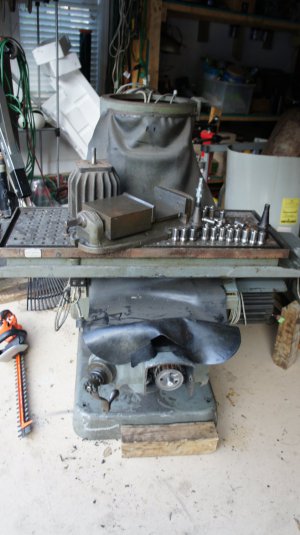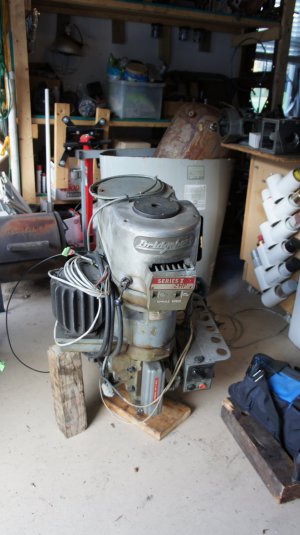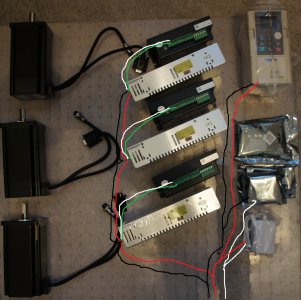- Joined
- Aug 13, 2020
- Messages
- 1,342
I am in the process of converting the Bridgeport CNC that I bought a week ago. It had an old Ah-ha! system attached, and the PO had bought a Centroid Acorn system for it. I prefer LinuxCNC, and I wanted to replace the dated steppers anyway. So, out with the old, and in with some new!!
I'm going to document the entire process in this post. Read the thread if you want to see the sausage getting made. But, if someone reads this post, I hope that they can follow along and have a successful build. First, what I'm working with.


A Bridgeport Series 1 CNC (Boss 3 as close as I can tell). Serial number CNC1324. I dropped it over on its face getting it in the garage. Broke off the Y-axis stepper and damaged the speed control. Repairs should be easy enough.
The steppers. I chose to go with the largest holding torque Nema 34 kit that StepperOnline had. I could have gone smaller and saved $20, but. . . seriously? I got the kit, because I figured the parts would be more or less compatible, if not optimized for one another.
The VFD to drive the spindle. I got the cheapest one that had modprobe/RS485 controls. I've used these cheap VFDs before. They're either DoA, or work for years, and this one came with an actual manual.
For the control computer, I'm using an Orange Pi 5. This is a Raspberry Pi clone. https://www.amazon.com/dp/B0BX9ZBYWJ
It requires a voltage level converter and a BOB (breakout board).
Wire it all up like this:

The power supplies accept 230V. To keep the current down, give it to them.
The VFD also needs 230V.
We'll pull one 120V leg over to power a 5V supply for the computer, and to the BOB which will control power to the automatic oiler and coolant pumps.
One of the first steps is to get LinuxCNC installed on the SBC (single board computer). For that, I'm following the directions posted here: https://forum.linuxcnc.org/18-computer/48079-can-the-opi5-be-configured-to-run-lcnc?start=90#269421
To be continued. . .
I'm going to document the entire process in this post. Read the thread if you want to see the sausage getting made. But, if someone reads this post, I hope that they can follow along and have a successful build. First, what I'm working with.


A Bridgeport Series 1 CNC (Boss 3 as close as I can tell). Serial number CNC1324. I dropped it over on its face getting it in the garage. Broke off the Y-axis stepper and damaged the speed control. Repairs should be easy enough.
The steppers. I chose to go with the largest holding torque Nema 34 kit that StepperOnline had. I could have gone smaller and saved $20, but. . . seriously? I got the kit, because I figured the parts would be more or less compatible, if not optimized for one another.
The VFD to drive the spindle. I got the cheapest one that had modprobe/RS485 controls. I've used these cheap VFDs before. They're either DoA, or work for years, and this one came with an actual manual.
For the control computer, I'm using an Orange Pi 5. This is a Raspberry Pi clone. https://www.amazon.com/dp/B0BX9ZBYWJ
It requires a voltage level converter and a BOB (breakout board).
Wire it all up like this:

The power supplies accept 230V. To keep the current down, give it to them.
The VFD also needs 230V.
We'll pull one 120V leg over to power a 5V supply for the computer, and to the BOB which will control power to the automatic oiler and coolant pumps.
One of the first steps is to get LinuxCNC installed on the SBC (single board computer). For that, I'm following the directions posted here: https://forum.linuxcnc.org/18-computer/48079-can-the-opi5-be-configured-to-run-lcnc?start=90#269421
To be continued. . .
Last edited:

